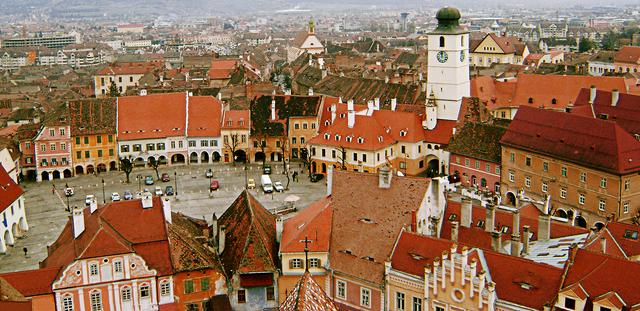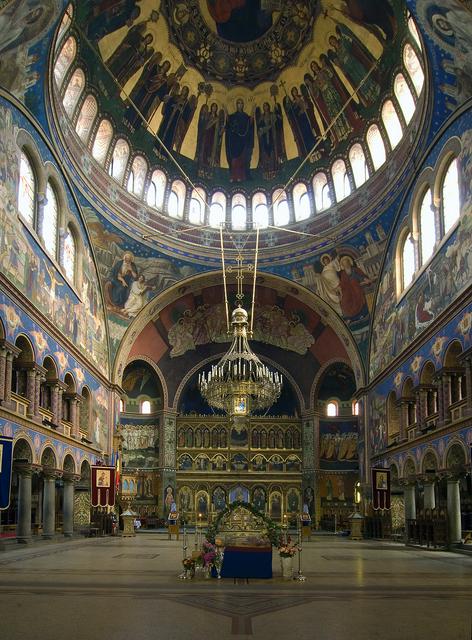Sibiu is a town in southern Transylvania, Romania, 280 km by road from Bucharest. The old town centre is very attractive. Sibiu is also a good base for exploring elsewhere in Transylvania.
 Known in German as Hermannstadt and in Hungarian as Nagyszeben, Sibiu has always been the centre of Romania's German minority since medieval times. Even today, it contains Romania's largest German community, and due to initiatives by the local government, the Germanic feel of the area has been maintained. Sibiu also has a Hungarian minority, remnants of Transylvania's past as part of the Hungarian Empire and, later, Austria-Hungary. Despite this, Sibiu is also distinctly Romanian (95% of the population today are ethnic Romanians) and manages to fuse these three cultures, as well as smaller minorities of Roma, Slovaks and Ukrainians into a city that is as wonderful as it is vibrant.
Known in German as Hermannstadt and in Hungarian as Nagyszeben, Sibiu has always been the centre of Romania's German minority since medieval times. Even today, it contains Romania's largest German community, and due to initiatives by the local government, the Germanic feel of the area has been maintained. Sibiu also has a Hungarian minority, remnants of Transylvania's past as part of the Hungarian Empire and, later, Austria-Hungary. Despite this, Sibiu is also distinctly Romanian (95% of the population today are ethnic Romanians) and manages to fuse these three cultures, as well as smaller minorities of Roma, Slovaks and Ukrainians into a city that is as wonderful as it is vibrant.
Today, Sibiu is one of Romania's cultural and tourism landmarks, attracting tourists due to its wonderful medieval charm, excellent views of the surrounding landscapes, great food, and stunning parkland. Sibiu today is also doing excellently economically, having an income per capita higher than the Romanian average.
Much of the city was reconstructed in preparation for being the European Capital of Culture in 2007. The people in Sibiu are much more relaxed and friendly than in Bucharest, and much of the city is pedestrian-friendly.

The Old Town is beautiful. It was mostly built in the late medieval period by the German merchants who were encouraged to settle in and around Sibiu. It’s in excellent condition, having escaped modern encroachments, and having been thoroughly renovated to be European Capital of Culture in 2007. (Standards were maintained in the following decade, in spite of economic woes.) Within Old Town, the Upper Town, containing most of the historic sights, is ranged around three squares: Piate Mare the Great Square, dominated by the RC Cathedral, Piata Mica the Little Square has most of the bars and cafés, and Piata Huet is an attractive Gothic conglomeration around the Lutheran Cathedral. The Lower Town is home to many charming buildings and cobbled squares.
Piata Mare and Piata Mica are linked by a passageway, above which stands the “Council Tower” or Turnul Sfatului.
- The Great Square.
- Huet Square.
- Turnul Sfatului. Climb the tower and get a panoramic view of Sibiu.
Multiple routes connect the Upper and Lower Towns, the two best being Pasajul Scărilor – the stairway from Piata Huet down into Str Turnului, and alternative cobbled ramp – and down Str Ocnei from Piata Mica under the Iron Bridge. This, being the traditional rendezvous of merchants and of lovers, is better known as “The Bridge of Liars”. About 200 m south of Piata Mare, paralleling Str Cetatii, is the surviving section of the Citadel Walls, with a series of towers and bastions. Beyond this hurries the traffic of the sprawling modern town: the spell is broken.
Churches of interest include:
- the Roman Catholic Cathedral on Piata Mare,
- St Mary's Lutheran Cathedral, on Piata Huet. The church is mostly closed for tenovations in 2018 and 2019, but you can still see its excellent collection of medieval tomb covers, including that of Vlad the Implaler's son, Vlad III, who is said to have been murdered by his enemies outside the chruch after an Easter Sunday service. The tower gives you the highest lookout over the city, and is reached via a series of steep wooden and stone staircases -- this is not for those with mobility or heart problems. Tower 5 lei, church 3 lei.
- St Ursuline’s on Str General Magheru, and *the stunning Orthodox Holy Trinity Cathedral (Catedrala Ortodoxă Sfânta Treime) on Str Mitropol.
The only museum that ranks as “must-see” is the skansen, the outdoor ASTRA Museum of Traditional Folk Civilization (Muzeul Civilizației Populare Tradiționale) 5 km south of the centre, and listed below. Sibiu’s other museums and galleries are important in a local context, for a nation that is not well endowed – where else could a Romanian go to see a genuine Egyptian mummy, or a Brueghel painting, without leaving the country? But Westerners have huge multicultural riches on their own doorsteps. See the other museums here if time and interest allow, but not through “fear of missing out”.
- Brukenthal National Museum. Named for Samuel Brukenthal, 18th-century governor of Transylvania. Paintings from the Dutch and Flemish schools, Italian schools and, of course German, Austrian and Romanian collections. Also displays Brukenthal's personal collection dating from the 15th-18th centuries.
- "Franz Binder" World Ethnography Museum. Curios that Binder and colleagues collected on their global travels.
- ASTRA Museum of Transylvanian Civilisation. Small exhibition space. In April 2017 it displayed 19th-century & modern icons.
- Steam Locomotives Museum. Decaying locomotives near the railway station.
- ASTRA Museum of Traditional Folk Civilization. Daily 09:00-18:00. Huge outdoor collection of traditional farmsteads, waterwheels, mills, labourers’ cottages, churches and so on, picturesquely ranged around a lake in Dumbrava Forest. Pick a fine day, but the circuit track is tarmac so it’s okay when wet. Allow 3 hours to stroll round. 20 lei adult, 10 lei concessions.
The Great Square.
Huet Square.
Turnul Sfatului. Climb the tower and get a panoramic view of Sibiu.
the Roman Catholic Cathedral on Piata Mare,
St Mary's Lutheran Cathedral, on Piata Huet. The church is mostly closed for tenovations in 2018 and 2019, but you can still see its excellent collection of medieval tomb covers, including that of Vlad the Implaler's son, Vlad III, who is said to have been murdered by his enemies outside the chruch after an Easter Sunday service. The tower gives you the highest lookout over the city, and is reached via a series of steep wooden and stone staircases -- this is not for those with mobility or heart problems. Tower 5 lei, church 3 lei.
Brukenthal National Museum. Named for Samuel Brukenthal, 18th-century governor of Transylvania. Paintings from the Dutch and Flemish schools, Italian schools and, of course German, Austrian and Romanian collections. Also displays Brukenthal's personal collection dating from the 15th-18th centuries.
"Franz Binder" World Ethnography Museum. Curios that Binder and colleagues collected on their global travels.
ASTRA Museum of Transylvanian Civilisation. Small exhibition space. In April 2017 it displayed 19th-century & modern icons.
Steam Locomotives Museum. Decaying locomotives near the railway station.
ASTRA Museum of Traditional Folk Civilization. Daily 09:00-18:00. Huge outdoor collection of traditional farmsteads, waterwheels, mills, labourers’ cottages, churches and so on, picturesquely ranged around a lake in Dumbrava Forest. Pick a fine day, but the circuit track is tarmac so it’s okay when wet. Allow 3 hours to stroll round. 20 lei adult, 10 lei concessions.
- Sibiu Music Festival - second weekend in September. Stages in each of the piatas and near the old city walls.
- After visiting ASTRA, continue driving south through the village of Rasinari, to see that charming rural Romania isn’t just in a museum. From there continue up to the road end at the ski resort of Paltinis. Or turn east for more village scenery via Cisnadioara and Cisnadie, till you loop back to Sibiu via the main north-south highway.
- Ocna Sibiului is a bathing resort some 15 km NE of Sibiu. The lakes are salt, formed by the flooding of ancient salt mines. In some, the waters are utterly black and opaque. Enticing, yes?
- Hike Fagaras Mountains and Cindrel Mountains.
- Guided bike tours around Sibiu.
- Guided enduro trips in the mountains, riding levels from tourist to hard.
- Go on the Transfăgărășan road, crossing the Fagaras mountains with dramatic views. Or Transalpina., an even higher road.
Sibiu Music Festival - second weekend in September. Stages in each of the piatas and near the old city walls.
Go on the [[Transfăgărășan]] road, crossing the Fagaras mountains with dramatic views. Or Transalpina., an even higher road.
Lots of souvenir and craft shops, especially on Piata Mica. German language book, incl. history and calenders, at the market square local beer in 2.5 L. botles. second things from rest of euorpase
You won’t go hungry. Food & drink here is to a good standard, and cheap by West European standards – reckon €30 for two people with two courses and drinks. The main concentration of restaurants, cafes and pubs is in and around Piata Mica. Hearty Transylvanian fare includes "ciorbă" (sour soup with various meat or veg), “sarmale” (stuffed cabbage leaves), stews and grills, often with mamaliga (polenta). Vegetarians and vegans shouldn’t starve but will need to enquire carefully. Also lots of fast food from familiar chains, but you can do better.
- Crama Sibiu Vechi, Str Papiu Ilarian 3, +40 269-210461. noon-midnight. Excellent cellar restaurant offering traditional Romanian cuisine at reasonable prices.
- La Cuptor, 9 Mai 7, +40 742 396 696. Daily 13:00-23:00. Good food at reasonable prices.
- Butoiul de Aur, Pasajul Scărilor (foot of stairway down to Str Turnului, +40 746 779 283. Daily 11:00-23:00. Long-established atmospheric place, good food.
Crama Sibiu Vechi, Str Papiu Ilarian 3, +40 269-210461. noon-midnight. Excellent cellar restaurant offering traditional Romanian cuisine at reasonable prices.
La Cuptor, 9 Mai 7, +40 742 396 696. Daily 13:00-23:00. Good food at reasonable prices.
Butoiul de Aur, Pasajul Scărilor (foot of stairway down to Str Turnului, +40 746 779 283. Daily 11:00-23:00. Long-established atmospheric place, good food.
A local speciality is a "meter" of beer served in pubs.
Club Liquid on Str Somesului is a night club which plays mainstream music. The audience is about 50% tourists/locals.
Undercover Society.
Spend at least a day exploring the nearby medieval fortified churches – you’ll need your own transport. The Saxon settlements of Transylvania came under attack in the 15th & 16th century, but instead of erecting castles, they fortified the churches with walls and lookout towers. Most examples are clustered around Medias, the best being the UNESCO World Heritage sites of Biertan and Valea Viilor.
Sighisoara has an attractive old citadel. It can be combined with a day-trip to the fortified churches, but stands as a centre in its own right. Other notable centres include Cluj-Napoca, Targu Mures, and Brasov. Further south, into Wallachia, is Curtea de Argeș an old fortress city in Muntenia.
If your itinerary includes Bucharest, try to visit it before Transylvania. It’s interesting but far from pretty, and it’s going to look especially drab after seeing Sibiu.
